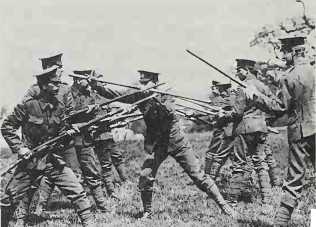Of operations, planning, logistics, shipbuilding, and appointments. With the formation of the Anglo-American Combined Chiefs of Staff, which called into being the American Joint Chiefs of Staff, in January 1942, King became part of bodies that were charged with the overall coordination of the British and American war effort, thus being able to influence the making of strategy at the highest level.
King overcame British objections to the diversion of resources from the Europe to the Pacific, and built up superior forces that were able to take the offensive against the Japanese earlier than planned. In the European theatre. King obtained a commitment to build escorts in large numbers, supervised their production, and centralized the American antisubmarine command. King’s selection of highly capable subordinate commanders, and delegation to them of considerable autonomy were also major contributions to the US naval success.
King’s intelligence, courage and determination made him a great war leader. He was also parochial, petty, tactless, and hot-tempered, and as a consequence a poor diplomat. A strict disciplinarian, he was never a popular officer. His effective service life ended shortly after the war. JTS.
King, W L Mackenzie (18741950). Canadian. As Canadian Prime Minister throughout World War II, he hosted two Allied conferences and eventually ushered in conscription.
King George U-class. British battleships: King George V, Prince of Wales, Duke of York, Anson, Howe launched 1939-40; 42,000 tons full load; 10 x 14 in guns. Well-protected and powerful; not significantly handicapped by Treaty im-posal of smaller armament than contemporaries. King George V flagship. Home Fleet, during Bismarck action, 1941; Sicily, 1943; first flagship, British Pacific Fleet, 1944; bombarded Japan, 1945. Prince of Wales badly damaged in Bismarck action; carried Churchill to Atlantic Conference; sunk by Japanese aircraft off Malaya, December 10 1941. Duke of York served Home Fleet, mostly as flagship, 1942—45, covering Arctic convoys and participating in Battle of North Cape; flagship, British Pacific Fleet, 1945. Survivors scrapped, 1957. DJL.
Kinkaid, Adm Thomas Cassin (1888—1972). US. One of the ablest US Navy commanders of World War II. Kinkaid commanded a cruiser force in the Battle of the Coral Sea, May 1942, when his handling of rescue operations for the survivors of uss Lexington was highly acclaimed. After heading carrier task forces off Guadalcanal, notably at Santa Cruz, Kinkaid relieved Rear Adm Robert Theobald (1884—1957) at the head of North Pacific Forces, successfully concluding the Aleutian Islands campaign. In November 1943 he succeeded Vice Adm Arthur Car-pender (1884-1960) in command of Seventh Fleet in Gen MacAr-thur’s Southwest Pacific Area. At Leyte Gulf, October 1944, division of command between Kinkaid’s Seventh and Halsey’s Third Fleet led to near-catastrophe: Seventh Fleet’s escort carriers fought desperately off Samar Island to keep Japanese heavy units from the US transports, while a peremptory radio message from Kinkaid recalled Halsey from his pursuit of Ozawa’s “decoy” force. Kinkaid commanded Seventh Fleet during the Leyte and Luzon campaigns. RO’N.
Kirishima see kongo.
Kirk, Adm Alan Goodrich (18881963). US. Naval Attache, London
1939-41 and 1942. Director of Naval Intelligence March-October
1941. He commanded the Atlantic Fleet Amphibious Force in the invasions of Sicily and Normandy (1943-44), then US Naval Forces in France. One of the great practitioners of amphibious war.
Kirk Kilisse see deception.
Kissinger, Henry A (b. l923). US. As special assistant for national security affairs to President Nixon, Kissinger sought to end US involvement in the Vietnam War on terms that would not undermine American credibility. He supported “Vietnamization” while secretly approaching Moscow and Peking (Beijing) to put pressure on Hanoi to compromise. It was Kissinger’s belief, however, that the trend in American public opinion favouring disengagement weakened Hanoi’s incentive to make concessions. Secret talks between Kissinger and his North Vietnamese counterpart, Le Due Tho, resulted in the Paris Agreement to end the war, signed on January 27 1973, for which both men were awarded the Nobel Peace Prize. WST.

Kitchener’s “New Armies” in training
Kitchener, Field Marshal Earl
(1850-1916). Br. Born in County Kerry, Kitchener was commissioned into the Royal Engineers in 1871 and by 1892 had become Sirdar of the Egyptian imy, reconquering the Sudan and defeating the Khalifa at Omdurman in 1898. He succeeded Roberts as c-in-c in South Africa in November 1900. His introduction of concentration camps aroused widespread criticism, although his attrition policy eventually wore down Boer resistance and he performed a conciliatory role in the 1902 peace settlement. As c-in-c in India from 1902 to 1909 he instituted overdue reforms, including the organization of standardized divisions and the modernization of training. In 1911 he went to Egypt as British Agent but, on August 5 1914, Asquith persuaded him to accept the post of Secretary of State for War. Virtually alone among Britain’s military and political leaders in predicting that the war against the Central Powers would be long and costly, his greatest contribution to the war effort lay in convincing the government and people that they must prepare for a protracted struggle.
Kitchener quickly began the task of mobilizing Britain’s resources and, in response to his appeals, nearly 2,500,000 men enlisted voluntarily before 1916, enabling him to expand the British Army to 70 divisions. He was fiercely attacked in May 1915 for the shell shortages experienced by the bef in France yet he had, in fact, done much to build the foundations for the huge increases in munitions production for which Lloyd George later claimed the credit. However, being accustomed to making his own decisions, and distrusting politicians, he was ill-at-ease in the Cabinet system of government, while his reluctance to delegate authority temporarily weakened the Army Council and General Staff. Kitchener himself did not take the lead in initiating alternative strategic ventures and showed irresolution throughout the Dardanelles campaign. Indeed, although he was still popular with the public, his power and influence within the Cabinet and Army declined perceptibly during 1915. He was drowned on June 5 1916 when the cruiser hms Hampshire, which was taking him on a military mission to Russia, struck a mine off the Orkneys. PJS.
Kitchener’s Army. Although frequently used as a collective term for the 2,466,719 men who volunteered for the British Army between August 1914 and December 1915, the name “Kitchener’s Army” is more accurately applied to 30 new divisions — numbered 9th to 26th and 30th to 41st — which were raised during the first 18 months of Lord Kitchener’s term of office as Secretary of State for War. The infantry battalions of these formations were called “Service” battalions to distinguish them from corresponding Regular and Territorial Force units. Nearly 40 percent of the “Service” and reserve battalions formed at this time were raised by local authorities, and many were known as “Pals” battalions, consisting as they did of recruits who lived in a particular city or district or who shared a common social and occupational background. “Kitchener’s Army” played a major role in the Battle of the Somme in 1916, where it suffered heavy casualties. PJS.
Kitson, Gen Sir Frank (b.1926) Br. An authority on irregular warfare and counterinsurgency operations, having acquired practical experience in Kenya, Malaya, Cyprus and Northern Ireland. When in Kenya 1953-55, served in a special unit formed to penetrate Mau Mau, using surrendered and captured terrorists in “pseudo-gangs” led by British officers disguised as native Kikuyu. As commander of an infantry brigade in Northern Ireland, achieved notable successes against Republican activists. Kitson subsequently became Commandant of the Staff College, Camberley, after commanding a division in the British Army of the Rhine, and was later c-in-c UK Land Forces. His Low Intensity Operations is in worldwide use as a textbook. MH.
Kiu-Lien-Cheng, Battle of (Battle of the Yalu, April 30-May 1 1904), Russo-Japanese War. A Japanese force of 40,000 (losses 1,100) under Kuroki forced a crossing of the Yalu river and drove the 7,000-strong (losses 3,500) Russian garrison from Kiu-Lien-Cheng.
Klopper, Gen Hendfik Balzazer
(b. l902). South African. Commander 2nd South African Division; responsible for the defence of Tobruk during the Battle of Gazala in June 1942; failed to defeat Rommel’s assault on June 20 and was forced to surrender the fortress.
Kluck, Col Gen Alexander von
(1846-1934). Ger. In 1914 Kluck, already 68, commanded German First Army, with the key role on the extreme right wing in the proposed sweep through Belgium and the wheel west of Paris. On August 17, in a belated attempt to ensure the coordination of the right wing armies, von Moltke, temporarily placed First Army under the more cautious von Billow, the Second Army commander, a step which Kluck resented. Billow’s desire to keep First Army within supporting distance prevented Kluck from outflanking the Allied left and brought him up against the bef at Mons on August
23. However, three days later, after Le Gateau, Kluck lost contact with the BEF, mistakenly believing that it was retreating to the west, not southwards. He was released from Billow’s direct control on August 27 but, tempted by the possibility of rolling up the French left wing, swung First Army inwards, east of Paris, thus exposing his own right to a counterattack from the direction of the French capital. During the ensuing Battle of the Marne between September 5 and 9, Kluck very skilfully reversed three of his corps and pivoted to the west to face the French Sixth Army on the Ourcq, yet in doing so he opened the gap between himself and Billow which prompted Molt-ke’s representative, Lt Col Hentsch, to order a withdrawal to the Aisne. Severely wounded in March 1915, Kluck retired the following year. PJS.
Kluge, Field Marshal Guenther Hans von (1882—1944). Having started as an artillery officer, Kluge held both staff posts and fleld commands on the Western Front in World War I. He did not become a convinced Nazi but saw benefits in cooperating with Hitler and commanded the German Fourth Army in the Polish and French campaigns, being promoted to Field Marshal in July 1940. During the advance towards Moscow in 1941 he was criticised by panzer leaders for over-cautious tactics, yet he retained Hitler’s support and replaced von Brock as commander of Army Group Centre on December 18. Nicknamed “Der Kluge Hans” (Clever Hans), he fought mainly defensive battles in 1942-43 and, though forced back to the Dnieper and beyond in the latter half of 1943, kept his forces and front relatively intact until a motor accident in October 1943. On July 2 1944 he succeeded von Rundstedt as c-in-c West. Kluge could not stop the Allied breakout from Normandy and was blamed for the failure of the Mortain counterattack early in August. While never fully committed to the antiHitler plot, his involvement was sufficient to render his position extremely precarious and his temporary disappearance on August 15, during the Falaise battle, caused Hitler to suspect him of negotiating with the Allies. He was replaced by Model two days later. On August 19, fearing disgrace and retribution, Kluge poisoned himself on his way back to Germany. MS.




 World History
World History









